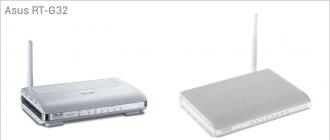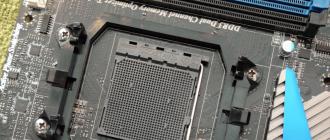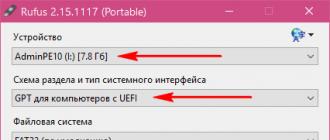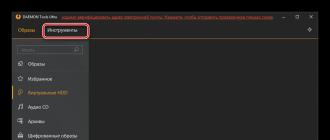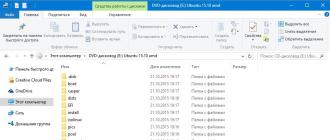date last update file 23.10.2009
Read only memory (ROM)
Very often in various applications it is required to store information that does not change during the operation of the device. This information such as programs in microcontrollers, boot loaders (BIOS) in computers, tables of coefficients of digital filters in, and, tables of sines and cosines in NCO and DDS. Almost always, this information is not required at the same time, so the simplest devices for storing permanent information (ROM) can be built on multiplexers. Sometimes in the translated literature, read-only memory is called ROM (read only memory). A diagram of such a read-only memory (ROM) is shown in Figure 1.
Figure 1. Schematic of read only memory (ROM) built on a multiplexer
In this circuit, a read-only memory is built with eight single-bit cells. Memorizing a specific bit in a one-bit cell is done by sealing the wire to the power source (writing one) or sealing the wire to the body (writing zero). In schematic diagrams, such a device is designated as shown in Figure 2.

Figure 2. Designation of read-only memory on schematic diagrams
In order to increase the capacity of the ROM memory cell, these microcircuits can be connected in parallel (the outputs and the recorded information naturally remain independent). The scheme of parallel connection of one-bit ROMs is shown in Figure 3.

Figure 3. Scheme of multi-bit ROM (ROM)
In real ROMs, information is recorded using the last operation of the microcircuit production - metallization. Metallization is carried out using a mask, therefore such ROMs are called masked ROMs... Another difference between real microcircuits and the simplified model given above is the use, in addition to the multiplexer, also. This solution makes it possible to transform a one-dimensional storage structure into a two-dimensional one and, thereby, significantly reduce the volume of the circuit required for the operation of the ROM circuit. This situation is illustrated by the following figure:

Figure 4. Diagram of masked read only memory (ROM)
Masked ROMs are depicted on schematic diagrams as shown in Figure 5. The addresses of memory cells in this microcircuit are fed to pins A0 ... A9. The microcircuit is selected by the CS signal. Using this signal, you can increase the amount of ROM (an example of using the CS signal is given in the discussion). Reading the microcircuit is performed by the RD signal.

Figure 5.Mask ROM (ROM) on schematic diagrams
The masked ROM is programmed at the manufacturing plant, which is very inconvenient for small and medium production series, not to mention the device development stage. Naturally, for large-scale production, masked ROMs are the cheapest type of ROM, and therefore are widely used today. Microcircuits have been developed for small and medium series of radio equipment production, which can be programmed in special devices - programmers. In these ROMs, the permanent connection of the conductors in the memory matrix is replaced by fusible links made of polycrystalline silicon. During the production of ROM, all jumpers are made, which is equivalent to writing logical units to all memory cells of the ROM. In the process of programming the ROM, increased power is supplied to the power pins and outputs of the microcircuit. In this case, if the power supply voltage (logical unit) is applied to the ROM output, then the current will not flow through the jumper and the jumper will remain intact. If a low voltage level is applied to the ROM output (connected to the case), then a current will flow through the memory matrix jumper, which will evaporate it, and upon subsequent reading of information from this ROM cell, a logical zero will be read.
Such microcircuits are called programmable ROM (EPROM) or PROM and are depicted on schematic diagrams as shown in Figure 6. As an example of a PROM, one can name the chips 155PE3, 556PT4, 556PT8 and others.

Figure 6. Conventional graphic designation of programmable read only memory (PROM) on circuit diagrams
Programmable ROMs have proven to be very convenient for small and medium batch production. However, when developing electronic devices, it is often necessary to change the program written to the ROM. In this case, the EPROM cannot be reused, therefore, once the written ROM with an erroneous or intermediate program has to be thrown out, which naturally increases the cost of hardware development. To eliminate this drawback, another type of ROM was developed, which could be erased and re-programmed.
UV erasable ROM is built on the basis of a memory matrix built on memory cells, internal organization which is shown in the following figure:

Figure 7. Memory cell of ROM with ultraviolet and electric erasure
The cell is a MOS transistor in which the gate is made of polysilicon. Then, during the manufacture of the microcircuit, this gate is oxidized and as a result it will be surrounded by silicon oxide - a dielectric with excellent insulating properties. In the described cell, with the ROM completely erased, there is no charge in the floating gate, and therefore the transistor does not conduct current. When programming the ROM, a high voltage is applied to the second gate, located above the floating gate, and charges are induced into the floating gate due to the tunneling effect. After removing the programming voltage, the induced charge remains on the floating gate, and therefore the transistor remains in a conducting state. The charge on the floating gate of such a cell can be stored for tens of years.
The described read-only memory does not differ from the previously described masked ROM. The only difference is that the cell described above is used instead of a fusible link. This type of ROM is called Reprogrammable Read Only Memory (EPROM) or EPROM. In the EPROM, the erasure of previously recorded information is carried out by ultraviolet radiation. In order for this light to pass unhindered to the semiconductor crystal, a quartz glass window is built into the ROM microcircuit case.

Figure 8. External view of erasable read-only memory (EPROM)
When the RPZU microcircuit is irradiated, the insulating properties of silicon oxide are lost, the accumulated charge from the floating gate flows into the semiconductor volume, and the transistor of the memory cell goes into a closed state. The erasure time of the EPROM chip ranges from 10 ... 30 minutes.
All read-only memory (ROM) can be divided into the following groups:
● programmable at manufacture (referred to as ROM or ROM);
● with one-time programming, which allows the user to change the state of the memory matrix electrically once by a given program(referred to as EPROM or PROM);
● reprogrammable (reprogrammable), with the possibility of multiple electrical reprogramming, with electrical or ultraviolet erasure of information (referred to as RPROM or RPROM).
All ROMs have tri-state outputs or open collector outputs in order to be able to combine on output when expanding memory.
(xtypo_quote) In EPROM, the drive is built on memory cells with fusible links made of nichrome or other refractory materials. The recording process consists in selectively burning through the fusible links. (/ xtypo_quote)
In EPROM, storage cells are built on the basis of MOS technologies. Various physical phenomena of charge storage at the interface between two different dielectric media or conductive and dielectric media are used.
In the first case, the dielectric under the gate of the MOS transistor is made of two layers: silicon nitride and silicon dioxide (SiN 4 - SiO 2). It was found that, in the complex structure of SiN 4 - SiO 2, when the electric voltage changes, charge hysteresis occurs at the interface between the two layers, which makes it possible to create storage cells.
In the second case, the basis of the memory cell is an avalanche-injection MOS floating gate transistor (LIPZ MOS). A simplified structure of such a transistor is shown in Fig. 3.77.
In an avalanche-injection transistor with a floating gate, at a sufficiently high voltage at the drain, a reversible avalanche breakdown of the dielectric occurs, and charge carriers are injected into the region of the floating gate. Since the floating gate is surrounded by a dielectric, the leakage current is small and information storage is provided for a long period of time (tens of years). When voltage is applied to the main gate, the charge dissipates due to the tunneling effect, i.e. erasure of information.
Here are some characteristics of the ROM (Table 3.1). 
The industry produces a large number of ROM chips. Let's give as an example two ROM chips (Fig. 3.78).

The following designations are used in the diagrams: A i - address inputs; D i - information outputs; CS - chip selection; CE - permission to exit.
The K573RF5 microcircuit is a reprogrammable ROM (EPROM) with ultraviolet erasure, having a 2Kx8 structure. In terms of input and output, this microcircuit is compatible with TTL structures. The K556RT5 microcircuit is a one-time programmable ROM, made on the basis of TTLSh-structures, is compatible with TTL-structures in input and output, having a 512bit x8 structure.
Very often in various applications it is required to store information that does not change during the operation of the device. This information such as programs in microcontrollers, boot loaders (BIOS) in computers, tables of digital filter coefficients in signal processors, DDC and DUC, tables of sines and cosines in NCO and DDS. Almost always, this information is not required at the same time, so the simplest devices for storing permanent information (ROM) can be built on multiplexers. Sometimes in translated literature, read-only memory is called ROM (read only memory). A diagram of such a read-only memory (ROM) is shown in Figure 3.1.
Figure 3.1. A read only memory (ROM) circuit based on a multiplexer.
 In this circuit, a read-only memory is built with eight single-bit cells. Memorizing a specific bit in a one-bit cell is done by sealing the wire to the power source (writing one) or sealing the wire to the body (writing zero). In schematic diagrams, such a device is designated as shown in Figure 3.2.
In this circuit, a read-only memory is built with eight single-bit cells. Memorizing a specific bit in a one-bit cell is done by sealing the wire to the power source (writing one) or sealing the wire to the body (writing zero). In schematic diagrams, such a device is designated as shown in Figure 3.2.
Figure 3.2. Permanent storage designation on schematic diagrams.
In order to increase the capacity of the ROM memory cell, these microcircuits can be connected in parallel (the outputs and the recorded information naturally remain independent). The scheme of parallel connection of one-bit ROMs is shown in Figure 3.3.

Figure 3.3 Scheme of multi-bit ROM (ROM).
In real ROMs, information is recorded using the last operation of the microcircuit production - metallization. Metallization is carried out using a mask, therefore such ROMs are called mask ROMs. Another difference between real microcircuits and the simplified model given above is the use of a demultiplexer in addition to the multiplexer. This solution makes it possible to transform a one-dimensional storage structure into a two-dimensional one and, thereby, significantly reduce the volume of the decoder circuit required for the operation of the ROM circuit. This situation is illustrated by the following figure:

Figure 3.4. A masked read only memory (ROM) circuit.
 Masked ROMs are shown in schematic diagrams as shown in Figure 3.5. The addresses of the memory cells in this microcircuit are fed to the pins A0 ... A9. The microcircuit is selected by the CS signal. Using this signal, you can increase the amount of ROM (an example of using the CS signal is given in the discussion of RAM). Reading the microcircuit is performed by the RD signal.
Masked ROMs are shown in schematic diagrams as shown in Figure 3.5. The addresses of the memory cells in this microcircuit are fed to the pins A0 ... A9. The microcircuit is selected by the CS signal. Using this signal, you can increase the amount of ROM (an example of using the CS signal is given in the discussion of RAM). Reading the microcircuit is performed by the RD signal.
Figure 3.5. Conventional graphic designation of masked ROM (ROM) on schematic diagrams.
The masked ROM is programmed at the manufacturing plant, which is very inconvenient for small and medium production series, not to mention the device development stage. Naturally, for large-scale production, masked ROMs are the cheapest type of ROM, and therefore are widely used today. Microcircuits have been developed for small and medium series of radio equipment production, which can be programmed in special devices - programmers. In these ROMs, the permanent connection of the conductors in the memory matrix is replaced by fusible links made of polycrystalline silicon. During the production of ROM, all jumpers are made, which is equivalent to writing logical units to all memory cells of the ROM. In the process of programming the ROM, increased power is supplied to the power pins and outputs of the microcircuit. In this case, if the power supply voltage (logical unit) is applied to the ROM output, then the current will not flow through the jumper and the jumper will remain intact. If a low voltage level is applied to the ROM output (connected to the case), then a current will flow through the memory matrix jumper, which will evaporate it, and upon subsequent reading of information from this ROM cell, a logical zero will be read.
 Such microcircuits are called programmable ROM (EPROM) or PROM and are depicted on schematic diagrams as shown in Figure 3.6. As an example of an EPROM, one can name the chips 155PE3, 556PT4, 556PT8 and others.
Such microcircuits are called programmable ROM (EPROM) or PROM and are depicted on schematic diagrams as shown in Figure 3.6. As an example of an EPROM, one can name the chips 155PE3, 556PT4, 556PT8 and others.
Figure 3.6. Conventional graphic designation of programmable read only memory (PROM) on schematic diagrams.
Programmable ROMs have proven to be very convenient for small and medium batch production. However, when developing electronic devices, it is often necessary to change the program written to the ROM. In this case, the EPROM cannot be reused, therefore, once the written ROM with an erroneous or intermediate program has to be thrown out, which naturally increases the cost of hardware development. To eliminate this drawback, another type of ROM was developed, which could be erased and re-programmed.
 The UV erasable ROM is built on the basis of a memory matrix built on memory cells, the internal structure of which is shown in the following figure:
The UV erasable ROM is built on the basis of a memory matrix built on memory cells, the internal structure of which is shown in the following figure:
Figure 3.7. Memory cell of ROM with ultraviolet and electric erasure.
The cell is a MOS transistor in which the gate is made of polysilicon. Then, during the manufacture of the microcircuit, this gate is oxidized and as a result it will be surrounded by silicon oxide - a dielectric with excellent insulating properties. In the described cell, with the ROM completely erased, there is no charge in the floating gate, and therefore the transistor does not conduct current. When programming the ROM, a high voltage is applied to the second gate, located above the floating gate, and charges are induced into the floating gate due to the tunneling effect. After removing the programming voltage, the induced charge remains on the floating gate, and therefore the transistor remains in a conducting state. The charge on the floating gate of such a cell can be stored for tens of years.
Structural scheme the described read-only memory does not differ from the previously described masked ROM. The only difference is that the cell described above is used instead of a fusible link. This type of ROM is called Reprogrammable Read Only Memory (EPROM) or EPROM. In the EPROM, the erasure of previously recorded information is carried out by ultraviolet radiation. In order for this light to pass unhindered to the semiconductor crystal, a quartz glass window is built into the ROM microcircuit case.
When the RPZU microcircuit is irradiated, the insulating properties of silicon oxide are lost, the accumulated charge from the floating gate flows into the semiconductor volume, and the transistor of the memory cell goes into a closed state. The erasing time of the RPZU chip ranges from 10 to 30 minutes.
 The number of write cycles - erasing EPROM chips is in the range from 10 to 100 times, after which the EPROM chip fails. This is due to the destructive effect of ultraviolet radiation on silicon oxide. As an example of EPROM microcircuits, one can name the 573 series of Russian-made microcircuits, and foreign-made 27cXXX microcircuits. The EPROM most often stores BIOS programs universal computers... EPROMs are depicted on schematic diagrams as shown in Figure 3.8.
The number of write cycles - erasing EPROM chips is in the range from 10 to 100 times, after which the EPROM chip fails. This is due to the destructive effect of ultraviolet radiation on silicon oxide. As an example of EPROM microcircuits, one can name the 573 series of Russian-made microcircuits, and foreign-made 27cXXX microcircuits. The EPROM most often stores BIOS programs universal computers... EPROMs are depicted on schematic diagrams as shown in Figure 3.8.
Figure 3.8. Conditional graphic designation of EPROM on schematic diagrams.
Since cases with a quartz window are very expensive, as well as a small number of write-erase cycles, they have led to the search for ways to erase information from an EPROM electrically. On this path, many difficulties were encountered, which have practically been resolved by now. Nowadays, microcircuits with electrical erasure of information are quite widespread. As a memory cell, they use the same cells as in the EPROM, but they are erased by electrical potential, so the number of write-erase cycles for these microcircuits reaches 1,000,000 times. The erasure time of a memory cell in such ROMs is reduced to 10 ms. The control circuit for electrically erasable programmable ROMs turned out to be complex, therefore, there were two directions for the development of these microcircuits:
1. EEPROM (EEPROM) - electrically erasable programmable read-only memory
 Electrically erasable EPROMs (EEPROM) are more expensive and smaller in volume, but they allow you to rewrite each memory cell separately. As a result, these microcircuits have maximum number write cycles - erase. The area of application of electrically erasable ROMs is storing data that should not be erased when the power is turned off. Such microcircuits include domestic microcircuits 573PP3, 558PP3 and foreign EEPROM microcircuits of the 28cXX series. Electrically Erasable ROMs are indicated on the schematic diagrams as shown in Figure 3.9.
Electrically erasable EPROMs (EEPROM) are more expensive and smaller in volume, but they allow you to rewrite each memory cell separately. As a result, these microcircuits have maximum number write cycles - erase. The area of application of electrically erasable ROMs is storing data that should not be erased when the power is turned off. Such microcircuits include domestic microcircuits 573PP3, 558PP3 and foreign EEPROM microcircuits of the 28cXX series. Electrically Erasable ROMs are indicated on the schematic diagrams as shown in Figure 3.9.
Figure 9. Conventional graphic designation of electrically erasable read-only memory (EEPROM) on schematic diagrams.
V recent times there was a tendency to reduce the size of the EEPROM by reducing the number of external outputs of microcircuits. For this, the address and data are transmitted to and from the microcircuit via the serial port. In this case, two types of serial ports are used - SPI port and I2C port (microcircuits 93cXX and 24cXX series, respectively). The foreign series 24cXX corresponds to the domestic series of 558PPX microcircuits.
 FLASH - ROM differ from EEPROM in that it is not erasing each cell separately, but of the entire microcircuit as a whole, or of the block of the memory matrix of this microcircuit, as was done in the EPROM.
FLASH - ROM differ from EEPROM in that it is not erasing each cell separately, but of the entire microcircuit as a whole, or of the block of the memory matrix of this microcircuit, as was done in the EPROM.
Figure 3.10. Conditional graphic designation of FLASH memory on schematic diagrams.
When accessing read-only memory, you must first set the address of the memory cell on the address bus, and then perform a read operation from the microcircuit. This timing diagram is shown in Figure 3.11.

Figure 3.11. Timing diagrams of signals for reading information from ROM.
In Figure 3.11, the arrows show the sequence in which the control signals should be generated. In this figure, RD is the read signal, A are the signals for selecting the cell address (since individual bits in the address bus can receive different meanings, then the paths of transition to both the single and zero state are shown), D is the output information read from the selected ROM cell.
4. Perform the addition operation in two's complement, representing the given terms in binary form:
1) + 45 2) - 45
- 20 + 20
Solution:
1) x 1 = 45 = 0.101101 pr
x 2 = - 20 = 1.010100 pr = 1.101011 arr = 1.101100 add
+ 1,101100
Answer: 0.011001 pr = 25 10
2) x 1 = - 45 = 1.101101 pr
x 2 = 20 = 0.010100 pr
+ 0,010100
Answer: 1.100111 add = 1.011000 arr = 1.011001 pr = - 25 10
Question number 5.
Complete the following tasks:
1) write the logical function in SNDF;
2) minimize the logical function using Karnaugh maps;
This article will tell you about what RAM and ROM are, as well as the differences.
Navigation
This article will tell you about what is RAM and ROM on a phone as well as ways to help clear the RAM of your smartphone on the Android platform.
In the world of technology, there are two sources of memory, the purpose of which is the same, but the principle of their operation is completely different. Therefore, when buying a tablet or phone, you should understand what the device's internal memory and random access memory (RAM) are.
What is the difference between RAM and ROM?

The main difference between the two types of memory is only their appointment.
Random access memory (RAM) – this device is intended for temporary storage of memory, which are running background processors, that is, programs, games, browser, etc. RAM formatting occurs when you turn off your smartphone or tablet. Therefore, when buying a smartphone, you should pay great attention to the amount of RAM memory.
Read only memory (ROM)- memory that is intended for storage operating system your smartphone or tablet. The memory device is usually a trigger element. It should be noted that given memory is indelible. After all, as you know, if the ROM fails, then the entire system of your device will crash, due to which your device will have to be returned for repair.
What is the internal storage of the device?
Internal memory of the device means a built-in memory card that is chip on the board of your device. It is intended for downloading applications, games and other .apk files, but not only that, you can also download family photos and videos to it, as well as music tracks.
What is external storage device?
External storage device is called the removable compartment for Micro SD memory cards, which is usually located under the battery, or on the bezel of your phone.
In turn, memory cards allow you to expand shared memory phone along with internal memory your device. Thanks to the large amount of memory on your device, you get more options, for example, you can download more movies or music tracks.
But to choice Micro SD memory cards must be approached more vigilantly and do not save money at her. After all, understand one thing, that if you buy cheap card memory, you will certainly save on it, but when you lose the photos from your family album, you will very much regret that you saved some money.
How to clear RAM memory on Android device?
There are quite a few ways to clean the memory of random access memory, or the so-called RAM, and now we will list the most effective of them.
Using an internal tool to clean the system.
Today, many manufacturers build in the RAM cleaning function by default, in order to provide the user with maximum comfort and convenience. After all, it is the "embedded utilities" that are the most effective and their action is performed with the help of one swipe on the smartphone, after which you will notice that the phone began to work faster, as background applications and processes were closed.

Cleaning RAM through the menu settings
This method allows you to more efficiently clean up the RAM memory.

To do this, you just need to go to "Menu", and then "Settings" and choose there Application Management where you need to go to the tab "Working"

From below you will see RAM memory as well as how busy and free she is. This tab contains programs that are this moment work in background process... Therefore, if you stop their work, you will notice that the RAM memory will begin to free up, and the phone will work faster.
Clean master- system optimization.
This program is quite popular in Google play, the only thing that tells about this is that if you enter the word "Cleaning", then the program Clean master will come first. And by the way, leadership this program, deserves quite rightly, because it is able to clean not only RAM, but also format the operating system from slag and unnecessary garbage on your device.

This program also allows you to determine the amount of RAM memory on your device. You can clear the RAM by pressing the button "Speed up"

It should be noted that the most effective method for cleaning RAM is the Clean Master program. But if you do not have the ability to access the Internet from a smartphone, then the built-in utilities for clearing the RAM memory are quite suitable for you, or if you understand the purpose of each of running programs, you can manually clear the RAM memory, but be careful that if you accidentally close an important program for your smartphone, then you can expect the platform to work incorrectly.
At the end of this article, I would like to emphasize that cleaning the RAM on a smartphone under Android in many ways plays the role of how it will behave, and what its performance will be.
Indeed, in order for the interaction to be optimal and sufficient for work, the memory must be cleaned after each use of the smartphone.
Video: How to free up RAM memory on a smartphone?
Computers and any electronics are complex devices, the principles of which are not always clear to most ordinary people. What is a ROM and why is a device needed? Most people will not be able to answer this question. Let's try to correct this misunderstanding.
What is ROM?
What are they and where are they used? Read-only memory (ROM) is a non-volatile memory. Technologically, they are implemented as a microcircuit. At the same time, we learned what the abbreviation for the ROM is. Devices are intended for storing information entered by the user, and installed programs... In the read-only memory, you can find documents, melodies, pictures - i.e. anything that needs to be stored for months or even years. The amount of memory, depending on the device used, can vary from several kilobytes (on the simplest devices with a single silicon crystal, an example of which are microcontrollers) to terabytes. The larger the ROM size, the more objects can be stored. The volume is directly proportional to the amount of data. If you condense the answer to the question of what is a ROM, the answer should be: it is one that does not depend on constant voltage.
Hard disks as primary read-only storage devices

The question of what is a ROM has already been answered. Now we should talk about what they are. The main read-only memory is hard drives... They are in everyone modern computer... They are used due to their wide possibilities of information accumulation. But at the same time there are a number of ROMs that use multiplexers, boot loaders and other similar electronic mechanisms). With a detailed study, it will be necessary not only to understand the meaning of the ROM. Deciphering other terms is also necessary in order to delve into the topic.
Expansion and addition of ROM capabilities thanks to flash technologies

If standard user is not enough, then you can use the additional expansion of the capabilities of the provided ROM in the field of data storage. This is done through modern technologies implemented in memory cards and USB flash drives. They are based on the principle of reusable use. In other words, the data on them can be erased and written tens and hundreds of thousands of times.
What is read-only memory

The ROM contains two parts, which are designated as ROM-A (for storing programs) and ROM-E (for issuing programs). Read-only memory type A is a diode-transformer matrix, which is stitched with address wires. This section of the ROM performs main function... The filling depends on the material from which the ROM is made (perforation and magnetic tapes, punched cards, magnetic disks, drums, ferrite tips, dielectrics and their electrostatic storage property).
Schematic structure of ROM

This electronics object is depicted as a device that is appearance resembles the connection of a certain number of one-bit cells. The ROM chip, despite its potential complexity and seemingly significant capabilities, is small in size. When a certain bit is memorized, it is sealed to the body (when zero is written) or to the power source (when one is written). To increase the capacity of memory cells in read-only memory devices, microcircuits can be connected in parallel. This is what manufacturers do to get a modern product, because the high-performance ROM chip allows them to be competitive in the market.
Memory volumes when used in various equipment

The amount of memory differs depending on the type and purpose of the ROM. So simple household appliances like washing machines or refrigerators, you can have enough installed microcontrollers (from their reserves of several tens of kilobytes), and in rare cases something more complex is installed. It makes no sense to use a large amount of ROM here, because the amount of electronics is small, and complex calculations are not required from the technology. For modern TVs something more perfect is already required. And the pinnacle of complexity is Computer Engineering like computers and servers, ROMs for which, at least, contain from several gigabytes (for those released 15 years ago) to tens and hundreds of terabytes of information.
Mask ROM

In cases where the recording is carried out using a metallization process and a mask is used, such a read-only memory is called mask. The addresses of memory cells in them are fed to 10 pins, and a specific microcircuit is selected using a special CS signal. Programming of this type of ROM is carried out at factories, as a result of which manufacturing in small and medium volumes is unprofitable and rather inconvenient. But with large-scale production, they are the cheapest among all permanent storage devices, which ensured their popularity.
Schematically, they differ from the total mass in that, in the storage matrix, the conductor connections are replaced by fusible jumpers made of polycrystalline silicon. During the production stage, all jumpers are created, and the computer assumes that logical units are written everywhere. But during preparatory programming, an increased voltage is applied, with the help of which logical units are left. When low voltages are applied, the jumpers evaporate, and the computer reads that there is a logical zero. This is the principle behind programmable read-only memory devices.
Programmable read only memory
EPROMs turned out to be convenient enough in the process of technological production so that they could be used for medium and small batch production. But such devices also have their limitations - for example, you can write a program only once (due to the fact that the jumpers evaporate once and for all). Because of this impossibility to reuse the read-only memory, it has to be discarded if it is written incorrectly. As a result, the cost of all the equipment produced increases. Due to the imperfection of the production cycle, this problem occupied the minds of memory device designers quite strongly. The way out of this situation was the development of a ROM that can be programmed anew many times.
UV or electrical erasable ROM

And such devices were called "read-only memory with ultraviolet or electric erasure." They are created on the basis of a memory matrix, in which memory cells have a special structure. So, each cell is a MOS transistor in which the gate is made of polycrystalline silicon. Similar to the previous option, right? But the peculiarity of these ROMs is that silicon is additionally surrounded by a dielectric with wonderful insulating properties - silicon dioxide. The principle of operation here is based on the content of the induction charge, which can be stored for decades. There are erasure features here. So, for an ultraviolet ROM device, it is necessary to get into ultraviolet rays coming from the outside (an ultraviolet lamp, etc.). Obviously, from the point of view of simplicity, the operation of read-only memories with electric erasure is optimal, since to activate them, you just need to apply voltage. The principle of electrical erasing has been successfully implemented in ROMs such as flash drives, which can be seen on many.
But such a ROM circuit, with the exception of cell construction, does not differ structurally from a conventional masked read only memory. Sometimes such devices are also called reprogrammable. But with all the advantages, there are certain limits to the speed of erasing information: this action usually takes about 10-30 minutes.
Despite the possibility of overwriting, reprogrammable devices have restrictions on their use. For example, UV-erasable electronics can survive 10 to 100 rewriting cycles. Then the destructive influence of radiation becomes so noticeable that they cease to function. You can see the use of such elements as repositories for BIOS programs, in video and sound cards, for additional ports. But the principle of electrical erasure is optimal for rewriting. So, the number of rewrites in ordinary devices ranges from 100,000 to 500,000! There are separate ROMs that can work more, but most users don't need them.

